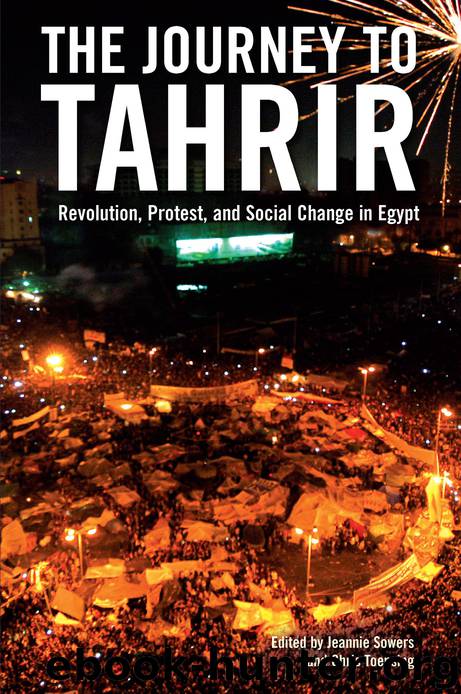The Journey to Tahrir by Jeannie Sowers

Author:Jeannie Sowers
Language: eng
Format: epub
Publisher: Verso Books
Published: 2012-05-08T16:00:00+00:00
CHAPTER 15
The Gama‘a Islamiyya: From Impasse to Opportunity
Ewan Stein
In the early 1990s, the security forces of Egypt were embroiled in a low-grade civil war with the Gama‘a Islamiyya (Islamic Group), an uncompromising outfit committed to the violent overthrow of the government. The Gama‘a, like the even more radical Egyptian Islamic Jihad and al-Takfir wa al-Hijra, grew out of study circles reading the works of Ibn Taymiyya and Sayyid Qutb, the intellectual godfathers of jihadi groups across the Muslim world, including al-Qaeda. Qutb taught that jahili (pagan) governments and social elites had usurped the entire realm of Islam. For his more extreme followers, war was not only permitted, but also mandated, to restore the Muslim world to righteousness. The enemy was everywhere; the Gama‘a did not distinguish between the Egyptian regime and its “infidel” US and Israeli allies, or between armed police and camera-toting tourists.1 The Muslim Brothers, whose ranks had included Qutb, had betrayed their past, he claimed, in the interest of accommodation with the regime.
In the summer of 2009 I interviewed the then de facto leader of the Gama‘a Islamiyya, Najih Ibrahim, for Middle East Report. At the time, the Gama‘a had won the international security community’s attention for its pioneering ideological “revisions” (muraja‘at), in which it renounced jihad against the Egyptian regime, violence against civilians, and other forms of terrorism. Much of the revisions literature, which ran to over twenty books, was written by Ibrahim, who reexamined Islamic sources to construct new justifications for the peaceful and conciliatory course. The works were vetted and approved by the Islamic Research Academy at al-Azhar, and attracted praise from such prominent clerics as Yusuf al-Qaradawi.
But despite the Gama‘a’s new status as poster child for de-radicalizing jihadists around the world, as a social and political movement within Egypt it had reached an impasse. Although most of the founding members (known as the “historic leadership”) had been freed from prison, along with thousands of lower-echelon cadres, the Mubarak regime kept the group on a tight leash. It was permitted to maintain a website but members were banned from preaching in mosques, speaking in public, or giving TV interviews. Leaders like Najih Ibrahim could not travel within, let alone outside, Egypt without approval from the security apparatus. Deprived of opportunities for da‘wa (proselytizing), and with an aging and dispirited core membership, it seemed the Gama‘a might simply wither on the vine.
The fall of Mubarak in February 2011 yielded a substantial dividend for Islamists of all stripes, despite the secondary role the Muslim Brothers, the salafis, and the Gama‘a Islamiyya played in the revolution itself. The Gama‘a, like these other groups, exudes a new self-confidence as it seeks to position itself as a credible mainstream—and vote-worthy—political and social movement that understands the material and spiritual concerns of the Egyptian masses.
But the Gama‘a, perhaps more than any other player in Egypt’s new political ferment, struggles to free itself from a checkered past. On the one hand, many Egyptians hold painful memories of the civil strife of
Download
This site does not store any files on its server. We only index and link to content provided by other sites. Please contact the content providers to delete copyright contents if any and email us, we'll remove relevant links or contents immediately.
| Africa | Americas |
| Arctic & Antarctica | Asia |
| Australia & Oceania | Europe |
| Middle East | Russia |
| United States | World |
| Ancient Civilizations | Military |
| Historical Study & Educational Resources |
Empire of the Sikhs by Patwant Singh(22767)
The Wind in My Hair by Masih Alinejad(4843)
The Templars by Dan Jones(4558)
Rise and Kill First by Ronen Bergman(4545)
The Rape of Nanking by Iris Chang(4023)
12 Strong by Doug Stanton(3419)
Blood and Sand by Alex Von Tunzelmann(3055)
The History of Jihad: From Muhammad to ISIS by Spencer Robert(2505)
Babylon's Ark by Lawrence Anthony(2431)
The Turkish Psychedelic Explosion by Daniel Spicer(2245)
Gideon's Spies: The Secret History of the Mossad by Gordon Thomas(2235)
No Room for Small Dreams by Shimon Peres(2235)
Inside the Middle East by Avi Melamed(2230)
Arabs by Eugene Rogan(2193)
The First Muslim The Story of Muhammad by Lesley Hazleton(2154)
Bus on Jaffa Road by Mike Kelly(2035)
Come, Tell Me How You Live by Mallowan Agatha Christie(2025)
Kabul 1841-42: Battle Story by Edmund Yorke(1921)
1453 by Roger Crowley(1880)
